
Brevig Mission is a city in Nome Census Area, Alaska. The population was 388 at the 2010 census, up from 276 in 2000. It is named for the Norwegian Lutheran pastor Tollef L. Brevig, who served at the mission that would later bear his name. First settled in 1900, the mission became known as Teller Mission before receiving its current name. The mostly Inupiat Eskimo population continues to practice subsistence. Brevig Mission is a dry village, which means the sale or possession of alcohol is illegal.

Teller is a city in the Nome Census Area, Alaska, United States. At the 2010 census the population was 229, a decrease from 268 in 2000.
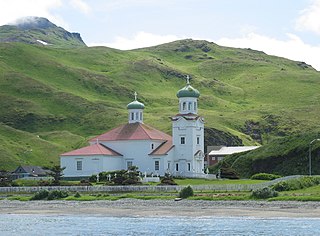
The Church of the Holy Ascension, also known as the Holy Ascension Orthodox Church, is a prominent landmark in Unalaska, the major community of the western Aleutian Islands in southwestern Alaska. The current church was built in 1894, probably on the site of an 1826 church, and likely using timbers and other elements from the older church. It is one of the oldest churches in Alaska, and is significant as the site from which missionaries brought their religion to the local Aleut people. This evangelization effort was so successful that today's Aleut population is still strongly Orthodox. The church was declared a National Historic Landmark for its architecture, and for its role in the history and culture of Alaska. It is the second cathedral church of the Orthodox Church in America Diocese of Alaska, after St. Michael's Cathedral in Sitka.

The Russian-American Building No. 29, also known as Tilson Building or Building No. 29, Sitka, is a historic commercial building at 202-206 Lincoln Street in Sitka, Alaska. A National Historic Landmark, it is the only Russian colonial commercial structure standing in Sitka, and one of only two Russian colonial buildings in the city
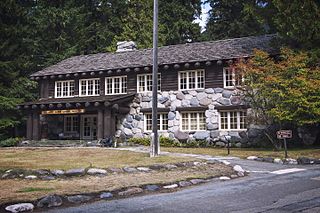
The Longmire Buildings in Mount Rainier National Park comprise the park's former administrative headquarters, and are among the most prominent examples of the National Park Service Rustic style in the national park system. They comprise the Longmire Community Building of 1927, the Administration Building of 1928, and the Longmire Service Station of 1929. Together, these structures were designated National Historic Landmarks on May 28, 1987. The administration and community buildings were designed by National Park Service staff under the direction of Thomas Chalmers Vint.
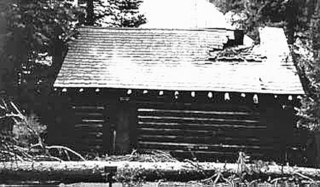
The Death Canyon Barn is a combination barn and ranger patrol cabin in Grand Teton National Park. The barn was built in Death Canyon on the Death Canyon Trail at its junction with the Alaska Basin Trail by the Civilian Conservation Corps in 1935 in the National Park Service rustic style. Located with a clear view of Prospector Mountain, it shares a common style and purpose with the Cascade Canyon Barn to the north in the park, with minor differences attributable to available materials and the preferences of the work crews building the barns.

Woody Island is located in Chiniak Bay, 2.6 miles (4.2 km) east of Kodiak, Alaska. It was originally settled by the native Alutiiq people who called themselves Tangirnarmiut, "the people of Tangirnaq." They inhabited and used Woody Island for thousands of years. The Russians established an agricultural colony on Woody Island in 1792. It was officially designated Wood Island in 1894 by the US Post Office and was the primary coastal settlement for commerce and trade for many years. The first road in Alaska was built on Woody Island. Aside from the Aleut presence, the island has gone through four periods of occupation by non-natives, and is largely unoccupied today. The island is approximately 2.8 miles long from north to south and 1.8 miles wide and 13 miles in circumference.
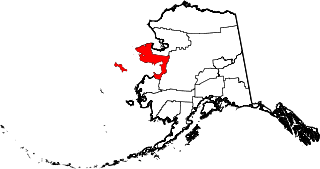
This is a list of the National Register of Historic Places listings in Nome Census Area, Alaska.

The Paradise Historic District comprises the historic portion of Paradise developed area of Mount Rainier National Park. The subalpine district surrounds its primary structure, the Paradise Inn, a rustic-style hotel built in 1917 to accommodate visitors to the park. The Paradise Inn is a National Historic Landmark. Five other buildings are included in the district. The district was placed on the National Register of Historic Places on March 13, 1991. It is part of the Mount Rainier National Historic Landmark District, which encompasses the entire park and which recognizes the park's inventory of Park Service-designed rustic architecture.

The Loomis Museum, also known as the Loomis Visitor Center, the Manzanita Lake Visitor Center and the Manzanita Lake Museum, was built by Benjamin Franklin Loomis in 1927 near Manzanita Lake, just outside Lassen Volcanic National Park in California, USA. Loomis was a local homesteader and photographer who documented the 1915 eruptions of Lassen Peak, and was instrumental in the 1916 establishment of the national park. In 1929 Loomis donated the museum and 40 acres (16 ha) of surrounding lands to the National Park Service, which since then has used the structure as an interpretational facility.

The Utkeagvik Church Manse, also known as the Utkeagvik Presbyterian Church Manse and The Pastor's House, is a historic church parsonage at 1268 Church Street in Utqiaġvik, Alaska. It is a two-story wood frame gambrel-roofed Dutch Colonial, and is distinctive as the only building of this style in Utqiaġvik. Built in 1930, it was also the first two-story building in the community, and the first to be built from a kit, a building method later widely adopted in Arctic Alaska. The kit was configured in Seattle, Washington, shipped by freighter to Utqiaġvik, and assembled by local Native Alaskan workers under the supervision of Dr. Henry Greist. Its construction was funded by the U.S. Presbyterian Board of Missions. Dr. Greist was for many years a pillar of the local community, who operated an outpatient medical clinic from this building. Geist was a medical doctor and Presbyterian minister who served the people of Utqiaġvik and the surrounding areas from 1921 to 1936. The name Utkeagvik is spelled Utqiaġvik in Iñupiaq, meaning "place to harvest edible roots".

The Russian Bishop's House, once the Russian Mission Orphanage, is a historic house museum and National Historic Landmark at Lincoln and Monastery Streets in Sitka, Alaska. Built in 1841–43, this log structure is one of the oldest surviving buildings of Russian America, and was one of the centerpieces of the Russian Orthodox church's efforts to spread its influence among the natives of Alaska. It was the home and administrative center of Ivan Veniaminov, the first Bishop of Alaska, later canonized as Innocent of Alaska. The house is now a unit of Sitka National Historical Park, and is administered by the National Park Service.
The Central House, also known as Erickson & Stade's, at Mile 128 on the Steese Highway in Central, Alaska, was a log structure built in 1926 by Riley Erickson and John Stade, replacing an 1894 log and sod structure that was burned in a 1925 fire. It served as a roadhouse restaurant and hotel, and was listed on the National Register of Historic Places in 1978.
The Sourdough Inn, at First and Sled Streets in Fort Yukon, Alaska, was built in 1926, by moving a disused Army building from Fort Egbert near Eagle, Alaska. It was then modified and opened as a hotel. It has also been known as the New Sourdough Hotel and has served as a restaurant, a hotel, a post office and, briefly in the 1940s, as a school.
The St. Nicholas Russian Orthodox Church is a historic Russian Orthodox church near Kwethluk, Alaska, United States, on the Lower Kuskokwim River. In 2017 it is part of the Diocese of Alaska of the Orthodox Church in America
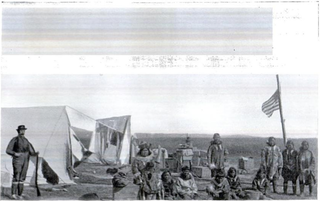
Teller Reindeer Station was located near Teller in the U.S. state of Alaska. The idea of transporting domestic reindeer from Siberia to western Alaska was first suggested by Captain Michael A. Healy, an officer in the United States Revenue Cutter Service, as a possible solution to the Native Alaskans' food shortage problem. The station was established in 1892 by Sheldon Jackson, Commissioner of Education in Alaska and a Presbyterian minister, who named it in honor of Henry M. Teller. The U.S. Government's Alaska Reindeer Service program ended in the early 1900s.
The Sutton Community Hall is a historic municipal building in Sutton, Alaska. It is located on the west side of Jonesville Road, about 0.25 miles (0.40 km) north of its junction with the Glenn Highway. It is a single-story wood-frame structure, measuring 40 by 70 feet, with a shallow-pitch gabled sheet metal roof. The building has entrances on the north, south and east sides, the east-facing one sheltered by a hood with diagonal bracing. The exterior has several types of cladding, including asphalt shingles and board-and-batten siding. The building was built in 1927 to serve as a bunkhouse for workers building the Eklutna Power Plant, and was moved to the present location in 1950 to serve the unincorporated community of Sutton as a meeting space. The hall served the community as its principal civic and social meeting space for forty years.

The Palmer Depot is a historic train station at South Valley Way and Evergreen Avenue in Palmer, Alaska. It is a large three-section single story frame structure, built in 1935 to provide transportation services to the newly established Matanuska Valley Colony. The main section is the former warehouse, which is 94 feet (29 m) long. The next section, with a lower profile than the warehouse, housed baggage facilities, a passenger waiting area, and living quarters for the station agent. The third section, the smallest of the three, houses the former ticketing office. The building now houses a community center.
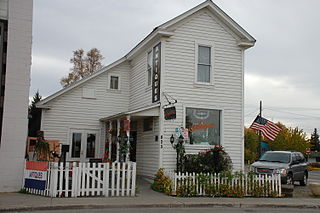
The Oddfellows House, also known as Oddfellows Hall, is a former fraternal clubhouse of Oddfellows at 825 1st Avenue in Fairbanks, Alaska. It is a wood-frame building with two sections, the front one a narrow two-story structure, the rear one a wider single-story structure. Each section has its own gable roof, although they do briefly align. The building was built in 1907 by Madame Renio, a fortune teller, and initially housed a clinic and residential space in the front and a bathhouse in the rear. The bathhouse business failed after its pipes froze in the winter of 1909–10, and the building was purchased by the local chapter of the International Order of Odd Fellows (IOOF). This fraternal organization converted the front space into a kitchen and bathroom, and the rear was converted into a large meeting hall. Under the IOOF's ownership the hall was used by a wide variety of civic and religious organizations, including its sister organization, the Golden North Rebekahs. The IOOF chapter was inactive between the late 1930s and 1945, but the Rebekahs continued to maintain the building, eventually taking ownership in 1967. The Rebekahs disbanded in 2007, and the space was briefly used as a museum; it now houses a retail establishment.
The Old Willow Community Center is a historic community building on West Willow Community Center Circle, off mile marker 69.7 of the Parks Highway in Willow, Alaska. It is a single-story log structure, measuring 60 by 40 feet, built out of local spruce. It is covered by a broad aluminum gabled roof; the gable ends are finished in wooden shingles. The interior consists of a single large chamber. The building was constructed in 1961 as part of a community drive for a meeting space that was more spacious than the local railroad station. In 1992, it was moved a short way south of its original location, where the new community center and library now stand. The building continues to be used for community events.

















